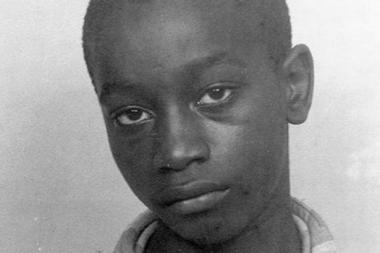
On June 12, 1944, the State of South Carolina executed by electrocution a ninety-pound Black boy, fourteen-year-old George Junius Stinney, Jr. (1929–1944), for the murder of two White girls, Mary Emma Thames (age seven) and Betty June Binniker (age eleven). Seven decades later, a judge vacated the conviction after determining that George was denied due process during the proceedings against him.
Born in Pinewood, South Carolina, George was one of five children born to George Stinney, Sr., and his wife Aimé. At the time of the girls' murders, the Stinneys lived in company housing in Alcolu, South Carolina, where George's father worked for the town's sawmill. The tragedy began at that company house on March 22, 1944, when the two White girls approached George and his seven-year-old sister, Aimé, as they were playing outside, asking them if they knew where to find a particular kind of flower. The girls then rode off on their bicycles in search of the flowers. The girls did not return to their homes that evening and the next day, March 23rd, a search party, in which George participated, found the girls' bodies in a ditch. They had been bludgeoned to death. During the search, George mentioned to someone in the party that he had seen the girls the previous day. A March 24th wire service story told of George's arrest for the murders (they misprinted his name as George Junius), saying the sheriff had obtained a confession.
After George was arrested, he was held at a jail in Columbia, South Carolina, for 81 days, during which time he was not allowed to see his parents. His father, in fact, had been fired from his job at the sawmill and the family fled town, fearing for their lives. Even if they had still been in the town, they would not have been permitted to attend George's trial—which lasted just one day, from jury selection to verdict—which was was in a Whites-only courthouse, with an all-White jury. During the two-and-a-half-hour trial, the lawyer representing George called no witnesses, did not cross-examine the prosecutor's three witnesses (the minister who found the bodies and two physicians who performed the post-mortem examinations), and offered no defense. Although the sheriff said George confessed to the crimes, he had no written confession. The jury deliberated for less than ten minutes and returned a guilty verdict, which was followed by the judge's sentencing of George to death by electrocution. George's defense attorney did not file an appeal. No transcript of the trial exists.
Many people and groups—the family, churches, the NAACP—appealed to the governor for clemency for the young boy but it was denied. George's parents were permitted to visit George one time after the trial and before the execution. At his execution, because he was so small, he sat on a Bible as a booster seat. After the executioner restrained his arms, legs, and body, he put the mask over his face. Again, because he was so small, the mask did not fit, and when the lethal electricity surged through his body, the mask fell off, revealing to the witnesses tears streaming down his face.
Seventy years later, in a January 2014 case hearing, George's siblings told how they had been with George at the time the murders took place. The minister who had found the bodies explained that the bodies appeared to have been moved to the spot where they were found. An inmate who knew George at the penitentiary said George repeatedly told him he had not confessed and that he was innocent. In December of that same year, rather than retry the case, the judge vacated George's conviction, saying he had not received a fair trial and had not been rightly defended and that his Sixth Amendment right (the right to legal counsel) had been violated.
In July 2015, at a memorial service organized by A New Day (A.N.D.), a local high school student said, "His conviction was mostly due to racial profiling and because of his race so we feel that keeping his memory alive is...like showing South Carolina...made a mistake and that these mistakes are still being made and we have to realize them and go back and look at how people are convicted and profiled." A stone tablet, with the following inscription, now stands in George's hometown of Alcolu:
GEORGE STINNEY, JR.
OCTOBER 21, 1929
JUNE 16, 1944
WRONGFULLY CONVICTED.
ILLEGALLY EXECUTED BY SOUTH CAROLINA.
CONVICTION VACATED BY COURT ORDER
DATED DECEMBER 16, 2014
A.N.D. JUNE 16, 2014
